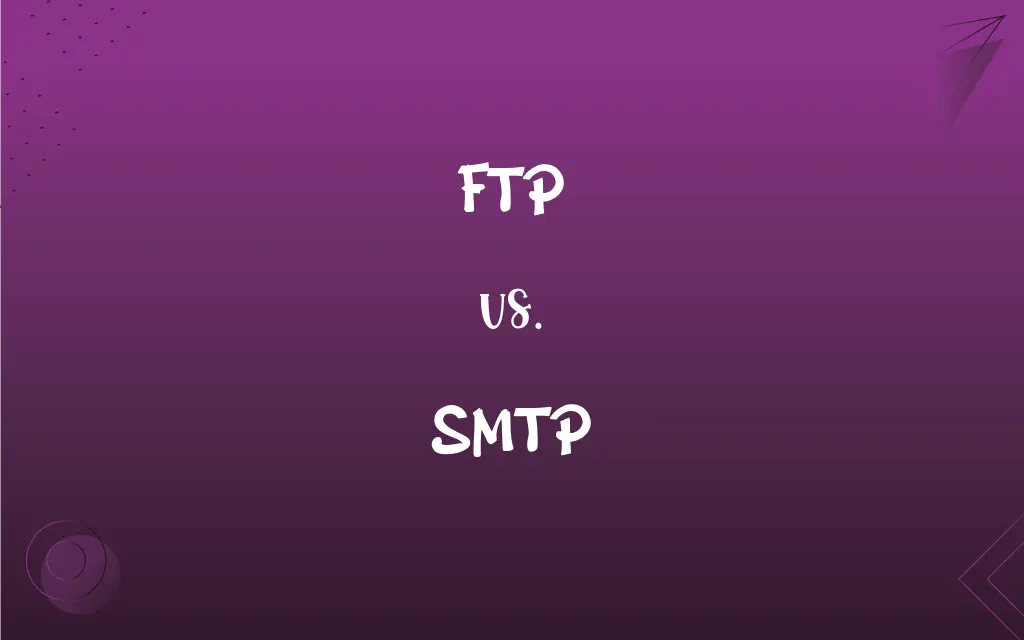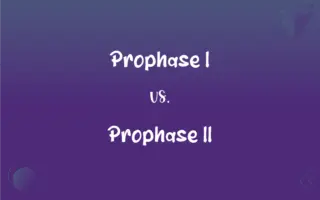FTP vs. SMTP: What's the Difference?
Edited by Aimie Carlson || By Janet White || Published on February 3, 2024
FTP (File Transfer Protocol) is used for transferring files over a network, while SMTP (Simple Mail Transfer Protocol) is used for sending emails.

Key Differences
FTP, or File Transfer Protocol, is a standard network protocol used for transferring computer files between a client and server on a computer network. SMTP, or Simple Mail Transfer Protocol, on the other hand, is a protocol used for sending emails from one server to another.
FTP operates on a client-server model and uses separate control and data connections between the client and server. SMTP, however, operates on a server-to-server model, primarily used for sending and forwarding emails.
FTP can transfer various types of files including text, binary, or multimedia files. SMTP is specifically designed for sending text-based messages (emails), not for file transfer.
In FTP, users can upload, download, rename, move, or delete files on a server. SMTP does not interact with files on a server; it simply transmits email messages to the recipient's mail server.
FTP requires authentication (username and password) for accessing files on a server, ensuring a secure transfer. SMTP also uses authentication but focuses on ensuring that emails are reliably and securely delivered.
ADVERTISEMENT
Comparison Chart
Primary Use
Transferring files
Sending emails
Operation Mode
Client-server model
Server-to-server model
Data Types Handled
Various types (text, binary, multimedia)
Primarily text-based messages
Interaction with Server
Upload, download, modify files
Transmits email messages
Authentication
Required for accessing files
Used for secure email delivery
ADVERTISEMENT
FTP and SMTP Definitions
FTP
FTP allows users to upload, download, and manage files on a server.
The developer updated the application via FTP.
SMTP
SMTP uses port 25, 587, or 465 for communications.
We switched to SMTP port 587 for better email security.
FTP
FTP operates on a client-server model, requiring authentication.
After entering my credentials in the FTP client, I accessed the remote server.
SMTP
SMTP is used by email clients and servers to communicate.
Our email client is configured with SMTP settings to send emails.
FTP
FTP can be secured using SSL/TLS for encrypted connections.
For secure file transfer, our company uses FTP over TLS.
SMTP
SMTP transfers email messages to mail servers for routing.
The SMTP protocol ensured the email reached the recipient's mail server.
FTP
FTP supports binary and ASCII data transfers.
We set the FTP client to binary mode to transfer the image files.
SMTP
SMTP can be secured with SSL/TLS for encrypted email transmission.
To protect sensitive information, our emails are sent using SMTP with SSL encryption.
FTP
FTP is a protocol for transferring files between computers on a network.
We used FTP to upload our website files to the hosting server.
SMTP
SMTP is a protocol for sending email messages over the Internet.
Our company's email server uses SMTP to send outgoing emails.
FTP
A communications protocol governing the transfer of files from one computer to another over a network.
FTP
To transfer (a file) using FTP.
FTP
To transfer a file using FTP.
FTP
An acronym for file transfer protocol, a standardized protocol used to allow transmission of files between computers; as, send me the file by ftp. It consists of a set of coded signals which are transmitted between computers, and which inform the receiving computer of the nature of a packet of information to be transmitted, and inform the transmitting computer when a packet has been successfully received.
FTP
To send from one computer to another by means of the standard file transfer protocol (ftp); as, he ftp'd me the file yesterday.
FTP
Protocol that allows users to copy files between their local system and any system they can reach on the network
FTP
Use the File Transfer Protocol to transfer data from one computer to another;
You can FTP these data
FAQs
What does FTP stand for?
File Transfer Protocol.
What is SMTP's full form?
Simple Mail Transfer Protocol.
How does FTP work?
FTP works by connecting a client and server for file transfer.
Is authentication required for FTP?
Yes, FTP usually requires a username and password.
Is SMTP used for file transfer?
No, SMTP is specifically for sending emails.
What ports does FTP use?
FTP commonly uses ports 20 and 21.
What port does SMTP use?
SMTP typically uses ports 25, 587, or 465.
Can FTP be used for email?
No, FTP is designed for file transfers, not email.
Does SMTP support multimedia content?
SMTP can send multimedia as email attachments, not directly.
Are there alternatives to FTP?
Yes, alternatives include SFTP and FTPS.
Can FTP handle multimedia files?
Yes, FTP can transfer multimedia and other file types.
What are alternatives to SMTP?
Alternatives include protocols like IMAP and POP3 for email retrieval.
What is the primary use of SMTP?
SMTP is primarily used for sending and forwarding emails.
Does SMTP require authentication?
SMTP often requires authentication for sending emails.
Is SMTP secure?
SMTP can be secured using SSL/TLS encryption.
How reliable is SMTP for email delivery?
SMTP is highly reliable for email delivery when properly configured.
Can FTP be encrypted?
Yes, using FTPS (FTP over SSL) or SFTP (SSH File Transfer Protocol).
Can SMTP work independently?
No, SMTP needs to work with other protocols for complete email services.
Can FTP be accessed through a web browser?
Yes, through web-based FTP clients.
Is FTP suitable for large file transfers?
Yes, FTP is often used for large file transfers.
About Author
Written by
Janet WhiteJanet White has been an esteemed writer and blogger for Difference Wiki. Holding a Master's degree in Science and Medical Journalism from the prestigious Boston University, she has consistently demonstrated her expertise and passion for her field. When she's not immersed in her work, Janet relishes her time exercising, delving into a good book, and cherishing moments with friends and family.
Edited by
Aimie CarlsonAimie Carlson, holding a master's degree in English literature, is a fervent English language enthusiast. She lends her writing talents to Difference Wiki, a prominent website that specializes in comparisons, offering readers insightful analyses that both captivate and inform.







































































